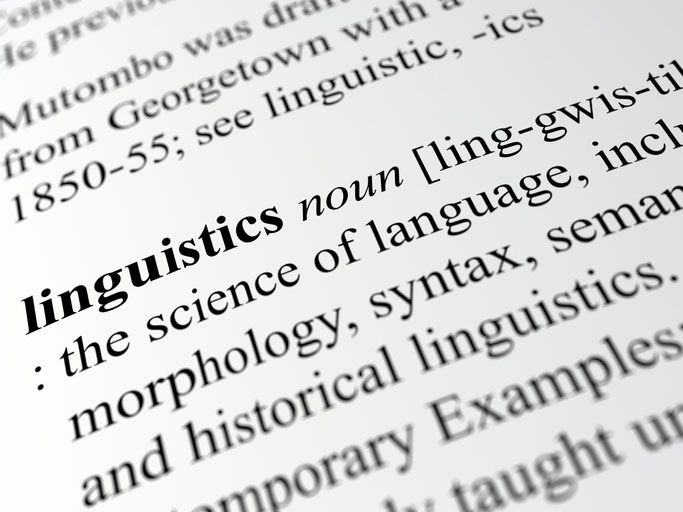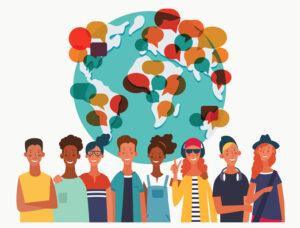

Language is something that sets people apart from all other animals, and linguistics is the scientific study of language. Language is what we use to tell stories, sing songs, recite poetry, and declare war; it’s uniquely human which makes it a perfect subject to study within a liberal arts backdrop.
The field of linguistics dates back to the 6th-century BC and is as relevant today as it ever was. In fact, recent developments in linguistics make right now the best and most exciting time to be involved in this field.
Linguists have always had an outsized influence on culture through their interdisciplinary work in fields like politics, religion, and literature. As such it’s particularly enriching to study this field within the wider context of the liberal arts.
What is Linguistics?
Linguistics is the study of language using the scientific method. Linguists study the grammatical structures, speech sounds, and word meanings of every one of the world’s more than 6,000 languages. Contrary to popular perceptions, linguists are not necessary multi-lingual; they may even specialize in studying a specific aspect of their native language.
The main categories of study within linguistics are:
- Pragmatics – how meaning is influenced by context
- Semantics – the meaning of sentences, phrases, and words
- Syntax – how words are combined and ordered to form sentences
- Morphology – how individual words are formed and structured
- Phonology – how sounds are organized within a language
- Phonetics – how language sounds are physically made by people
Beyond these basic elements, linguistics also melds with psychology, neurology, computer science, and history to create separate, interdisciplinary fields.
Psycholinguistics, for example is the study of the psychology of language. Using computers to create linguistic models forms the field of computational linguistics. The neurology of the brain and how it influences language begets the field of neurolinguistics. And the study of language throughout history as it has changed over time is the field of historical linguistics.
And linguistics itself is a broad, interdisciplinary field that strives to understand one of the key traits that is uniquely human. This is why the liberal arts provides a perfect environment in which to study linguistics.
Technology is Breaking All New Ground in the Field of Linguistics
 Fortunately, there’s no time like the present to study linguistics. Today’s modern technology has given linguists tools that would have seemed like magic to linguists just a century ago.
Fortunately, there’s no time like the present to study linguistics. Today’s modern technology has given linguists tools that would have seemed like magic to linguists just a century ago.
Google Translate is a case in point. This was developed first on what’s known as statistical machine translation (SMT) and more recently on neural machine translation (NMT). SMT compares the same text written in two different languages and uses statistical models to determine the most probable correlations between words. SMT is similar but instead of making word-by-word comparison its more advanced levels of statistical analysis are able to make sentence-by-sentence comparisons.
SMT versus NMT for computer translation programs demonstrated what professional translators have always known: that the meaning of a passage is better preserved in a sentence-by-sentence translation rather than a word-by-word translation.
This might not seem especially magical, but now consider this: when linguists were developing the statistical algorithms used in Google Translate, they did not include any language dictionaries or grammar rules. In fact, the only materials the computer program analyzed were identical copies of documents written in different languages.
The Google Translate linguists took advantage of the fact that the United Nations and European Union publish their documents in multiple languages, meticulously translated by humans. They simply fed these documents into the SMT and NMT programs and the programs developed the rules for syntax and semantics all on their own through extensive statistical modeling.
Over the years and after translating billions of sentences the NMT software has been refined to the point of creating a very solid template for basic human language, at least for the official languages of the EU and UN. Between those two there are 27 languages represented, which means the Google Translate NMT software can effectively translate between languages spoken by more than half the people on earth. The instant universal translator, in the realm of science fiction just decades ago, is a reality today.
Linguistic tools like Google Translate have an immeasurable impact on bringing the world’s people together through a shared ability to communicate. This has enormous implications that can be both helpful and harmful. And this is why studying linguistics in a liberal arts context, one that includes cultural sensitivity, tradition and logic, is so vital.
A Universal Rosetta Stone, the Linguist’s Dream Can Be Realized Through the Liberal Arts
The implications of software with a foundational human language template become immediately apparent. We’re moving towards a universal Rosetta Stone.
Writing is considered to have developed independently in three areas: China, the Middle East, and Central America. When the conquistadors were besieging Mayan cities, they were puzzled at the reverence the Mayan priests showed to their written codices. They seemed to sacrifice everything to save their writings, and when all hope was lost, they witnessed the priests weeping as they destroyed their scripts lest they fall into the hands of the conquistadors.
Some of those ancient Mayan writings have been preserved, but many parts are indecipherable in the present day. Software like NMT is currently being applied to try and decipher the remaining written texts that the Mayans so revered and protected with their lives.
The prospect of linguistics being able to apply software to decode written languages that remain undecipherable today is extraordinary, and discoveries made in this endeavor could revolutionize entire branches of linguistics, not to mention history. For linguists, the possibility of reading any of these mystery languages is a tantalizing prospect:
- Linear A – The writing system used by Minoans in Crete.
- Khitan script – This is the writing system of a language that went extinct roughly a thousand years ago. Khitan was the official language of the Liao Empire in northeast China.
- Zapotec script – One of the earliest writing systems in Central America, this was used around present-day Oaxaca, Mexico.
- Rongorongo glyphs – This glyphic writing system was discovered on Easter Island in the South Pacific and is as shrouded in mystery as the island’s original inhabitants.
- Byblos script – A script written on spatulas and bronze plates from the ancient Lebanese city Byblos.
There’s something poetic that we need today’s most advanced technology to be able to understand some of the world’s oldest writing systems. The revelations the field of linguistics will make in this endeavor will have wide-ranging implications on cultural studies, history, religious studies, poetry and literature. This is why it’s important to apply the knowledge gleaned from linguistics in the broader context of the liberal arts.
Linguistics is A Well-Established Discipline Within the Liberal Arts
 Linguistics has been a subject of inquiry since the Indian grammarian Panini founded the field in the 6th-century BC. Since then, the torch of study has been passed down to the present through countless civilizations and cultures. This includes significant contributions from the Persians, the Greeks, the British, the Prussians, and many more.
Linguistics has been a subject of inquiry since the Indian grammarian Panini founded the field in the 6th-century BC. Since then, the torch of study has been passed down to the present through countless civilizations and cultures. This includes significant contributions from the Persians, the Greeks, the British, the Prussians, and many more.
Today some of the most famous linguists include:
Noam Chomsky – Best known for his political activism and being one of the most-cited authors in the world, Chomsky is also a linguist and is credited with being the founder of the theories of universal grammar and generative grammar.
J.R.R. Tolkien – Though best known for works like the Lord of the Rings trilogy, Tolkien worked for a time at the Oxford English Dictionary where he researched the etymological origin of words, and afterwards did academic research on Middle English.
Noah Webster – Lexicography is a branch of linguistics that studies the vocabulary of a language, and Webster is best known for his pursuits in this field which resulted in his eponymous Webster’s Dictionary. A federalist, Webster’s lexicon is credited with shaping the direction of 19th century American political thought, in addition to inspiring poets like Emily Dickinson.
It’s not an accident that the prominent linguists we know today have made significant contributions in other fields like politics, literature, and culture. This is a reflection of how linguistics is inter-related with other fields in the liberal arts, and how they enrich each other.




